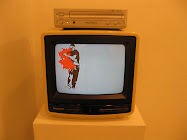Patricia Johnson wrote a review of the War & Peace & Quiet show at Moody HERE, but I think mine is better.

via Artshouston
Suzanne Bloom, MANUAL and Ed Hill, War & Peace & Quiet @ Moody Gallery
The tightest of three September ‘War’ themed exhibits in town, War & Peace & Quiet finds collaborators Ed Hill and Suzanne Bloom looking to the past, present and future of our current conflict and exploring the corresponding grief, indignancy and hope that Americans find themselves experiencing at the sixth anniversary of the War on Terror. In three distinct bodies of work a timeline is established; Ed Hill reaches back to draw upon Renaissance masters and Mexican lithographs to contextualize the Iraq War as a macabre constant in Western art, the collaborative effort MANUAL slams simple, reductive polemics through digital compositions, and Suzanne Bloom explores music as a visual medium in a crossbred installation creating beauty through language, AK47s and totenkopf portraits. Walking through the gallery, the three projects lead the viewer from the indelible past through a polarizing present and into the back gallery, where horror and hope are found, whimsically illustrated as the notes of a musical composition.
In a large series of sketches and drawings Ed Hill returns to a medium he had abandoned for over three decades; the two subjects broached here steer the mind to our exposure to photographs of American soldiers and historical representations of war from art historical sources. In the artist’s hand solitary figures march, watch or wait; the sketchiness of his execution fuels their imagined movement. Wounded Soldier presents its subject as a foreshortened figure lying prone, only his bandaged face and right arm are finished in color. With the ghost of Luis Jimenez, Raphael Sanzio or Jose Posada sitting on his shoulder, Hill has labored on another group of works twisting other epoch’s symbolization of war. Though well executed, the disparate sources relate to too many loose ends to be coherent, in trying to rope a large swath of history under his singular vision they seem confused. Boogie Nights in Baghdad takes the gleefully deceased figures of the Mexican social conflict popularized by Posada in the late 1800s to the streets of Iraq’s capitol, but without grounding references the intent fades to replication.
MANUAL, a thirty-year project that eclipses the career of either of its members, is well known as a pioneer in computer-aided art. The alter-ego has allowed Bloom and Hill to confront their emotional subject head on as they set up simple relationships like WAR-GAME and NATURAL-HISTORY as both opposing polemics and synchronistic, everyday phrases. While they may be accurately described as radical, the niche this body of work fills is full of the bile that has been building throughout the United States. Danse Macabre, all the way at the back of the space in a naturally lit gallery, is the strongest of the projects on display. On a large television a looping series of five musical compositions plays, alternating dulcet tones and raucous, cacophonous blasts. The five works are displayed as framed images, and their line drawings of weapons of war and peaceful figures are the basis for the music. If you’ve ever wanted to know what sound a skull makes when it is ‘played’ Bloom has given you a representation that transcends both aural and visual mediums, like Schoenberg’s atonal experiments that broke open musical forms in the beginning of the 20th century. Listening to the works and watching the shapes and figures being played is delightful, the highlight of the group being Truth Assassinated, a work for the Russian journalist Anna Politkovskya, gunned down last year for her inquiries into corruption. Available as edition works and DVDs, their simple evocations of messy world politics are a clear bell when experienced with an open mind- one can hope for them to be distributed and appreciated through the same digital channels that provide horror and war to the world in video, words and music.























2 comments:
Yes, much better. Funny how the quality of a review improves in direct proportion to how much it actually, you know, talks about the art, or something. Also much more interesting when a review makes an interesting essay out of the issues surrounding the work. You go.
I'm obligated to point out, however, that the Chronicle did in fact mention that the artists married in 1974. This is what art journalism is all about.
On the other hand, neither review mentioned Mantegna.
thanks! but, dammit (mantegna)! then again i could have brought up direct references to raphael too.
Post a Comment